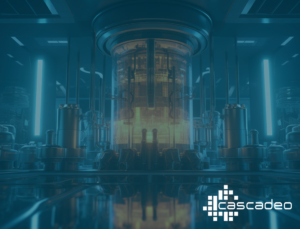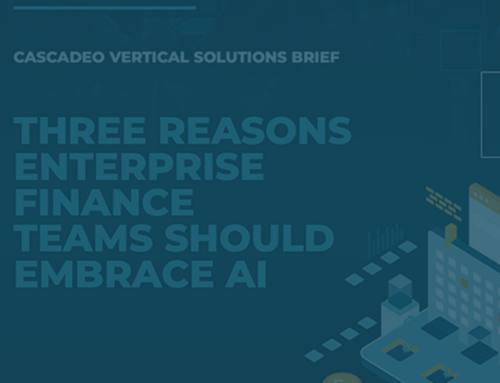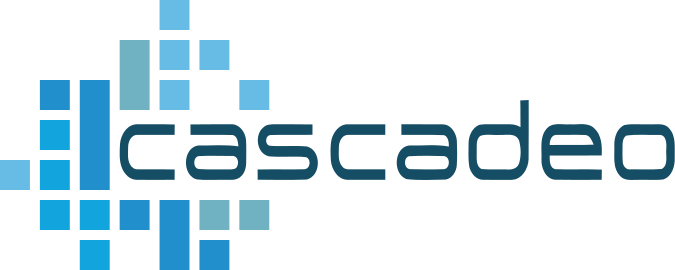
Nuclear power is a bridge to a renewable energy era, offering a proven and scalable solution to the pressing problems of climate change and pollution. Learn how generative AI can be used to support its safe, scalable development in this guest post by Cascadeo CTO Jared Reimer.
Generative AI can support safe, sustainable Nuclear Power
 There are very few things everyone can agree on when it comes to energy policy. Despite the overwhelming evidence and consensus of the world’s scientific community, many people—particularly in the United States—reject the idea that human activities (specifically the combustion of fossil fuels) are altering the climate and environment. Whatever you may believe about climate change, we all breathe the same air. Aside from obscure corner cases like the “rollin’ coal” modification of diesel trucks, even the most adamant climate science denier can see, smell, and feel the effects of air pollution in our population centers. The visible effects of particulate pollution are universally understood—it is impossible not to notice smog or clouds of diesel soot from older trucks that lack particulate filters (DPFs).
There are very few things everyone can agree on when it comes to energy policy. Despite the overwhelming evidence and consensus of the world’s scientific community, many people—particularly in the United States—reject the idea that human activities (specifically the combustion of fossil fuels) are altering the climate and environment. Whatever you may believe about climate change, we all breathe the same air. Aside from obscure corner cases like the “rollin’ coal” modification of diesel trucks, even the most adamant climate science denier can see, smell, and feel the effects of air pollution in our population centers. The visible effects of particulate pollution are universally understood—it is impossible not to notice smog or clouds of diesel soot from older trucks that lack particulate filters (DPFs).
Limited Solutions
Unfortunately, we have very few options for addressing both the climate change and pollution problems in the immediate term. Generating enough energy to sustain civilization as we know it can only be done today through two proven methods: burning things and fission. We can and must augment with solar, wind, geothermal, and other renewable sources—but we need massive baseline generation capability that is both reliable and free of emissions, and we need it immediately. Lack of understanding about nuclear safety and lobbying on the part of petroleum and coal companies have led to inaction or worse—the construction of more fossil-fuel-burning generation facilities because of artificial obstacles to the deployment of proven technologies like nuclear power.
A Nuclear-Powered Future
There is cause for great optimism—both immediately and in the near future. Nuclear power stands as the beacon of hope in our quest for a sustainable future. It is a bridge to a renewable energy era, offering a proven and scalable solution to the pressing problems of climate change and pollution. In fact, there are currently 93 nuclear reactors generating power at 54 plants in 28 states, which have safely supplied over one-fifth of U.S. electricity since 1990. But one-fifth is not enough, and the number of plants in operation has been on the decline since 1998—the opposite of the progress we need. The fear instilled by the public by media and “astroturfed” environmental movements opposing nuclear power has had the effect of making the construction of new reactors nearly impossible in our country for decades.
Gen AI and Nuclear Power
The integration of generative AI into nuclear power development, deployment, operationalization, and improvement will bring about a new age of efficiency, safety, and cost-effectiveness. Generative AI can play a multifaceted role in revolutionizing nuclear power, focusing on fission, fusion, small modular reactors, various fuel sources, reprocessing spent fuel, safe disposal of waste, and future exploration.
Power for Now: Nuclear Fission
Nuclear fission—the process of splitting atomic nuclei to release energy—is presently the cornerstone of nuclear power. It is incredibly clean, safe, free of emissions, and scales to the levels required to sustain civilization as we know it. Rare and preventable incidents like the Chernobyl and Fukushima disasters have caused an outsized fear of nuclear fission, and an enormous amount of money is spent opposing nuclear power by well-intentioned but misguided environmentalists (often indirectly funded by the fossil fuel industry), playing up these fears. Opposition has been raised to the disposal of fission waste, as well, although existing nuclear facilities have been disposing of waste without any safety incidents since 1969. The number of actual fatalities attributed to nuclear power is a tiny fraction of the death and disease caused by fossil fuel refining, distribution, and combustion. The fatality rate per unit of energy produced is near zero for nuclear power, with only a handful of deaths over many decades. By contrast, according to one study, coal-fired power plants have killed at least 460,000 Americans during the past two decades, causing twice as many premature deaths as previously thought, with an average of more than 43,000 deaths per year.
Gen AI and Nuclear Fission
Despite the rare accidents of the past, nuclear power is by far the safest and cleanest form of reliable, mass-scale energy production known to humankind. Generative AI can support deployment and safe operation of this technology in three key ways:
- Safety Monitoring and Operational Efficiency: Through predictive maintenance and real-time monitoring, AI can anticipate and prevent potential failures, thereby increasing operational efficiency and safety. This is crucial in prolonging the lifespan of nuclear facilities and reducing downtime.
- Waste Management: AI can aid in finding innovative methods for waste disposal and recycling, reducing environmental impact. Machine learning models can predict the behavior of radioactive materials over time, assisting in developing safe storage solutions and options for reprocessing spent fuel.
- Design Optimization: AI algorithms can analyze vast datasets to optimize reactor designs, leading to more efficient and safer reactors. For example, AI can simulate countless scenarios to identify the most effective reactor core configurations, improving energy output while minimizing risks
Power for the Future: Nuclear Fusion
Nuclear fusion, often dubbed the “holy grail” of energy production, promises vast (nearly infinite) amounts of clean, inexpensive energy. While a handful of experiments have generated fusion that produced more energy than it consumed, an achievement known as “ignition,” fusion as an energy source remains at present aspirational, but, if harnessed, could meet the world’s energy demands and provide energy to developing countries before they deploy more coal and other fossil-fuel-fired generation facilities. AI’s role in developing fusion technology is pivotal:
- Plasma Control: Achieving fusion requires superheating plasma to temperatures hotter than the sun’s core, usually via magnetic fields or high-powered lasers. Controlling the plasma within a fusion reactor is an exceedingly complex task. Generative AI can process real-time data to adjust magnetic fields and other parameters, stabilizing the plasma for sustained fusion reactions. It is one thing to achieve ignition—another entirely to continuously operate a fusion reactor.
- Materials Analysis: AI can accelerate the development of new materials capable of withstanding extreme conditions inside fusion reactors, thus advancing the feasibility of commercialized fusion energy.
Power Near You
Small Modular Reactors (SMRs) offer a more flexible and scalable approach to nuclear power than currently operating facilities. AI can revolutionize SMRs in several ways:
- Modular Design and Deployment: AI can streamline the design process of modular components, ensuring they are optimized for the required use cases and environments.
- Remote Monitoring and Control: AI enables advanced remote monitoring, ensuring efficient operation and rapid (often automated) response to any anomalies, which is crucial for SMRs deployed in remote areas with limited on-site staff.
Alternative Fuels
Additionally, the exploration of alternative nuclear fuels (such as Thorium and the reprocessing of spent uranium fuel) can benefit greatly from AI:
- Fuel Efficiency Analysis: AI can model and simulate the behavior of various fuel types, including reprocessed spent fuel, providing insights into their efficiency, safety, and environmental impact. This has the added benefit of reducing or eliminating the small quantities of highly radioactive waste produced by today’s fission reactors.
- Supply Chain Optimization: AI can optimize the supply chain for nuclear fuel production and transportation, reducing costs and improving reliability.
- Waste Reduction: AI can help maximize reusability of fuels. It turns out that the waste currently produced by fission reactors can be reprocessed and used to generate more electricity while accelerating the decomposition of the most dangerous elements into less-toxic waste. Sadly R&D in to this critical area has languished for the past few decades, primarily for political reasons, but AI promises to reinvigorate and accelerate this dramatically.
New Frontiers in Power
Looking towards the future, AI will be central in exploring new frontiers in nuclear power. Among these new opportunities are:
- Advanced Reactor Designs: Generative AI can conceptualize new reactor designs that surpass current limitations, potentially unlocking more efficient and safer nuclear technologies. Among other use cases, generating synthetic data, scenarios, iterating on existing and proposed designs, and generating new approaches to known problems are all within the capabilities of today’s AI technology.
- Environmental Impact Assessments: AI can accurately predict the long-term environmental impacts of nuclear power, aiding in policy-making and public perception. This speeds regulatory approval, reduces the “NIMBY problem” by disarming arguments with data, and improves confidence in both existing and future reactor designs.
- Integration with Renewable Sources: AI can facilitate the integration of nuclear power with other renewable energy sources, creating a more resilient and sustainable energy grid. More effectively managing power distribution is one of the most important steps in electrification and can often result in more usable capacity from the infrastructure we already own and have fully paid for.
- Public Relations: AI can assist in translating technical data and protective measures into plain language to improve public comprehension of the safety and efficacy of nuclear power. Communicating the benefits, safety, efficacy, and necessity of nuclear power is difficult topic. Tailoring that messaging to different constituent audiences in ways that resonate and are appropriate for their level of understanding is essential. AI can generate this content and tune it to an audience of one, rather than trying to create one-size-fits-all content that is relevant to people of varying backgrounds, beliefs, biases and experiences.
A Transformative Force
In conclusion, generative AI is not just a new tool but a truly transformative force in the critical area of scaling and advancing nuclear power. As we stand at the crossroads of an energy crisis and a growing climate emergency, nuclear power—enhanced and optimized by AI—emerges as the only viable option that reaches sufficient scale in the immediate term. Efforts to reduce fossil fuel usage like EVs and improved heating and cooling efficiencies are also essential, but won’t produce the rapid results we need. This is not an either/or – we must do both: solve the diversification of supply and decouple the consumption of energy from a single input fuel.
In summary, nuclear power is the sole proven technology capable of reducing carbon emissions swiftly and significantly at massive scale, acting as the only bridge we have to a renewable future. Communicating its strong safety record to the public to foster a wider understanding of the unlikelihood of adverse events must be a policy priority. AI will be transformative in improving these communications to diverse audiences globally. Embracing nuclear power wholeheartedly, with the aid of generative AI, is not just an option but a necessity for the survival of human civilization as we know it. It may not be the bridge everyone wants, but it is the bridge we have, and we must use it while we still have the chance to limit the worst impacts of air pollution and climate change. The future can be bright—if only we choose leaders who understand, accept, and articulate the need for a nuclear renaissance worldwide. Onward and upward, powered by AI.




